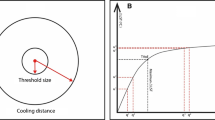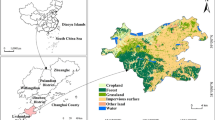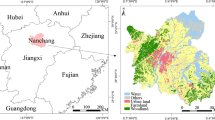Abstract
Context
Urban integration has exacerbated the spreading of urban heat islands (UHIs) across cities. Blue/green landscapes embedded within urban areas, behaving as cool islands (CIs), have been highly focused due to their efficient cooling effects.
Objectives
Previous studies on the cooling effect of blue/green landscapes are mainly focused on isolated patches of CIs, which cannot provide a stable cooling service compared to connected ones. Thus, based on the ‘source-corridor-network’ paradigm, a new approach to mitigating cross-regional UHI effects was proposed through improving the connectivity of CIs.
Methods
Taking Guangzhou-Foshan Metropolitan Area (GFMA), one of the most densely settled regions in China, as the case study context, the localized contour tree method, minimum cumulative resistance model, and complex networks were integrated to identify and evaluate the source areas and connecting corridors of the cooling network.
Results
35 cooling sources and 78 CI connecting corridors were identified across the GFMA. CIs within built-up areas such as parks had higher cooling intensity acting to hinder UHI from spreading while CIs in mountainous areas offer larger cooling coverage. The CI connecting corridors in northeast GFMA were dense and short while those at the junction of the two cities were sparse and long, which should be highly focused. The cooling network was composed of the hierarchically constructed CI source areas and corridors, which provided impetus and stability for mitigating UHI effect respectively.
Conclusions
The landscape connectivity approach proposed in this study can serve as a cooling network strategy in metropolitan areas, revealing important policy implications for cities with potential cross-regional UHI threat.








Similar content being viewed by others
References
Beaujean S, Nor ANM, Brewer T et al (2021) A multistep approach to improving connectivity and co-use of spatial ecological networks in cities. Landsc Ecol 36:2077–2093
Bottema M (1997) Urban roughness modelling in relation to pollutant dispersion. Atmos Environ 31:3059–3075
Byrne J, Jinjun Y (2009) Can urban greenspace combat climate change? Towards a subtropical cities research agenda. Aust Plan 46:36–43
Chen Z, Yu B, Song W, Liu H, Wu Q, Shi K, Wu J (2017) A new approach for detecting urban centers and their spatial structure with nighttime light remote sensing. IEEE Trans Geosci Remote Sens 55:6305–6319
Chen S, Yu Z, Liu M, Da L, Faiz M (2021) Trends of the contributions of biophysical (climate) and socioeconomic elements to regional heat islands. Sci Rep 11(1):12696
Debbage N, Shepherd JM (2015) The urban heat island effect and city contiguity. Comput Environ Urban Syst 54:181–194
Depietri Y (2020) The social–ecological dimension of vulnerability and risk to natural hazards. Sustain Sci 15:587–604
Dong J, Peng J, Xu Z, Liu Y, Wang X, Li B (2021) Integrating regional and interregional approaches to identify ecological security patterns. Landsc Ecol 36:2151–2164
Du H, Wang D, Wang Y, Zhao X, Fei Q, Hong J, Cai Y (2016) Influences of land cover types, meteorological conditions, anthropogenic heat and urban area on surface urban heat island in the Yangtze river delta urban agglomeration. Sci Total Environ 571(15):461–470
Estoque RC, Ooba M, Seposo XT, Togawa T, Hijioka Y, Takahashi K, Nakamura S (2020) Heat health risk assessment in Philippine cities using remotely sensed data and social-ecological indicators. Nat Commun 11:1–12
European Environment Agency (2016) Urban adaptation to climate change in Europe 2016—transforming cities in a changing climate. European Environment Agency, Kongens Nytorv6, 1050 Copenhagen K, Denmark
Gu C, Hu L, Cook IG (2017) China’s urbanization in 1949–2015: processes and driving forces. Chin Geogr Sci 27(6):847–859
Guo G, Wu Z, Cao Z, Chen Y, Zheng Z (2021) Location of greenspace matters: a new approach to investigating the effect of the greenspace spatial pattern on urban heat environment. Landsc Ecol 36:1533–1548
Knaapen JP, Scheffer M, Harms B (1992) Estimating habitat isolation in landscape planning. Landsc Urban Plan 23:1–16
Kong F, Yin H, James P, Hutyra LR, He HS (2014) Effects of spatial pattern of greenspace on urban cooling in a large metropolitan area of eastern China. Landsc Urban Plan 128:35–47
Li H, Meier F, Lee X, Chakraborty T, Liu J, Schaap M, Sodoudi S (2018) Interaction between urban heat island and urban pollution island during summer in Berlin. Sci Total Environ 636:818–828
Maimaitiyiming M, Ghulam A, Tiyip T, Pla F, Latorre-Carmona P, Halik Ü, Sawut M, Caetano M (2014) Effects of green space spatial pattern on land surface temperature: Implications for sustainable urban planning and climate change adaptation. ISPRS-J Photogramm Remote Sens 89:59–66
Norton BA, Coutts AM, Livesley SJ, Harris RJ, Hunter AM, Williams NS (2015) Planning for cooler cities: a framework to prioritize green infrastructure to mitigate high temperatures in urban landscapes. Landsc Urban Plan 134:127–138
Oke TR (1982) The energetic basis of the urban heat island. Q J R Meteorol Soc 108:1–24
Peng J, Xie P, Liu Y, Ma J (2016) Urban thermal environment dynamics and associated landscape pattern factors: a case study in the Beijing metropolitan region. Remote Sens Environ 173:145–155
Peng J, Jia J, Liu Y, Li H, Wu J (2018) Seasonal contrast of the dominant factors for spatial distribution of land surface temperature in urban areas. Remote Sens Environ 215:255–267
Peng J, Liu Q, Xu Z, Lyu D, Du Y, Qiao R, Wu J (2020) How to effectively mitigate urban heat island effect? A perspective of waterbody patch size threshold. Landsc Urban Plan 202:103873
Rizwan AM, Dennis LY, Chunho L (2008) A review on the generation, determination and mitigation of Urban Heat Island. J Environ Sci 20:120–128
Santamouris M (2014) On the energy impact of urban heat island and global warming on buildings. Energy Build 82:100–113
Tan J, Zheng Y, Tang X, Guo C, Li L, Song G, Zhen X, Yuan D, Kalkstein AJ, Li F (2010) The urban heat island and its impact on heat waves and human health in Shanghai. Int J Biometeorol 54:75–84
Wu Q, Liu H, Wang S, Yu B, Beck R, Hinkel K (2015) A localized contour tree method for deriving geometric and topological properties of complex surface depressions based on high-resolution topographical data. Int J Geogr Inf Sci 29:2041–2060
Wu W, Ren HY, Yu M, Wang Z (2018) Distinct influences of urban villages on urban heat islands: a case study in the Pearl River Delta, China. Int J Environ Res Public Health 15(8):1666
Wu S, Yang H, Luo P, Luo C, Li H, Liu M, Ruan Y, Zhang S, Xiang P, Jia H, Cheng Y (2021) The effects of the cooling efficiency of urban wetlands in an inland megacity: a case study of Chengdu, Southwest China. Build Environ 204:108128
Xue Z, Hou G, Zhang Z, Lyu X, Jiang M, Zou Y, Shen X, Wang J, Liu X (2019) Quantifying the cooling-effects of urban and peri-urban wetlands using remote sensing data: case study of cities of Northeast China. Landsc Urban Plan 182:92–100
Yu Q, Yue D, Wang Y, Kai S, Fang M, Ma H, Zhang Q, Huang Y (2018) Optimization of ecological node layout and stability analysis of ecological network in desert oasis: a typical case study of ecological fragile zone located at Deng Kou County (Inner Mongolia). Ecol Indic 84:304–318
Yu Z, Yang G, Zuo S, Jørgensen G, Koga M, Vejre H (2020) Critical review on the cooling effect of urban blue-green space: a threshold-size perspective. Urban For Urban Green 49:126630
Yu Z, Fryd O, Sun R, Jørgensen G, Yang G, Özdil C, Vejre H (2021a) Where and how to cool? An idealized urban thermal security pattern model. Landsc Ecol 36:2165–2174
Yu Z, Zhang J, Yang G (2021b) How to build a heat network to alleviate surface heat island effect? Sust Cities Soc 74:103135
Zoulia I, Santamouris M, Dimoudi A (2009) Monitoring the effect of urban green areas on the heat island in Athens. Environ Monit Assess 156:275–292
Acknowledgements
This research was financially supported by National Natural Science Foundation of China (41671182).
Author information
Authors and Affiliations
Corresponding author
Ethics declarations
Conflict of interest
The authors have no conflicts of interest to declare.
Consent for publication
All authors gave consent to publication of the manuscript.
Additional information
Publisher’s note
Springer Nature remains neutral with regard to jurisdictional claims in published maps and institutional affiliations.
Rights and permissions
About this article
Cite this article
Peng, J., Cheng, X., Hu, Y. et al. A landscape connectivity approach to mitigating the urban heat island effect. Landsc Ecol 37, 1707–1719 (2022). https://doi.org/10.1007/s10980-022-01439-3
Received:
Accepted:
Published:
Issue Date:
DOI: https://doi.org/10.1007/s10980-022-01439-3




